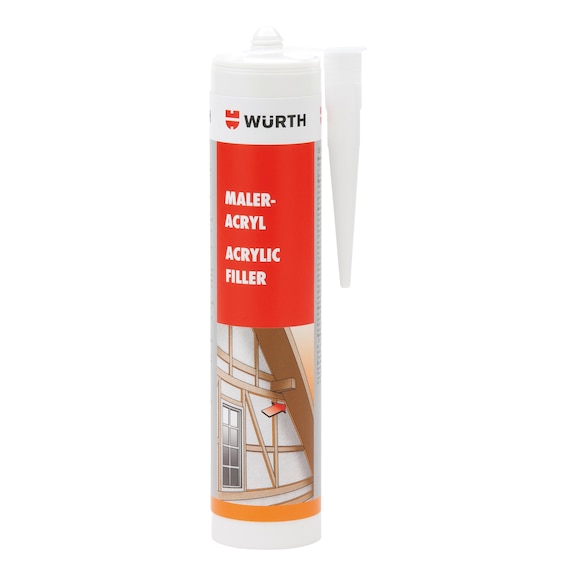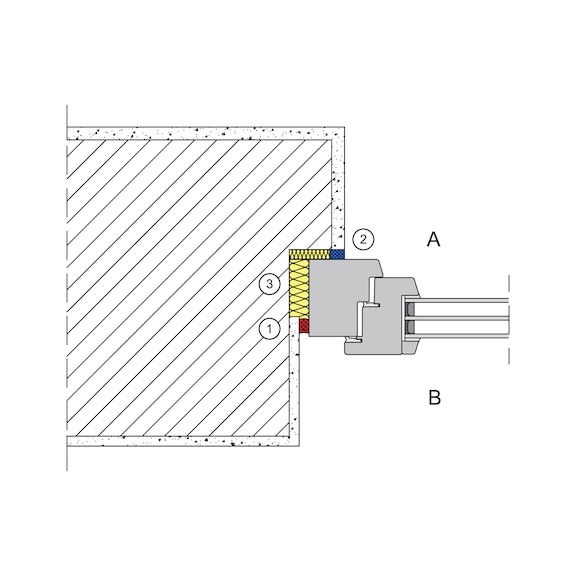For detailed information, other images and documents, please select individual articles from the following table.
Painter's acrylic
High-quality acrylic sealant for window sealing inside and other internal and external expansion joints
Register now and access more than 125,000 products


Variants
The sealant can be coated/plastered, excellent adhesion to most common paints and brushes
Due to the wide variety of paint and lacquer formulas available, we recommend that you always carry out preliminary testing in order to rule out any interactions. Caution: Sealant joints that have been fully painted over tend to crack when movement occurs in the joint, as the applied paint is generally less elastic than the sealant.
- Highly elastic
- Broad adhesive range on a range of standard construction surfaces
- Building material class B2 according to DIN 4102
- Silicone-free
- Resistant to ageing, weathering and UV
- Odourless
Our products featuring the EMICODE label are low emission/environmentally compatible. The EMICODE classification system awards labels to construction products that comply with the very stringent health and environmental requirements of recognised institutes.
Not suitable for use in building construction joints in accordance with DIN 18540. Due to the wide variety of paint and lacquer formulas available, we recommend that you always carry out preliminary testing in order to rule out any interactions. Caution: Sealant joints that have been fully painted over tend to crack when movement occurs in the joint, as the applied paint is generally less elastic than the sealant. The setting speed is dependent on the application temperature, the weather and the surface moisture. The speed is greatly delayed in cold, damp weather. Discolouration may occur in wood containing tannic acid. For vertical joints, please observe the run-off behaviour of the sealant. May cause corrosion on metals such as steel, copper and zinc-plated surfaces.
Standing water should be prevented in the acrylic joint as this can lead to erosion.
Acrylic is very unstable in terms of water absorption and release. Since the diffusion behaviour also changes as a result of the differences in water adsorption in the material, neither the water vapour diffusion resistance (μ) nor the diffusion-equivalent air layer thickness (SD) can be measured on this material in accordance with DIN EN 12572. The value of 5,000 is the average value obtained through testing.
Do not use in applications involving contact with pre-compressed sealing tapes.
Paint acrylic is not suitable for adhesive bonding or filling cavities. Due to the large number of varnish and glazing formulations available, especially on alkyd resin paints and powder-coated aluminium, always carry out your own tests on the area first.
Tested in accordance with EN 15651 Part 1
- Fire behaviour: Class E
- Stability under load: ≤ 3 mm
- Volume loss: ≤ 25 %
- Tensile behaviour after immersion in water (at 23°C), ductile: ≥ 100 %
- Durability: Passed
EMICODE EC1plus: Very low emissions: The EMICODE classification system distinguishes the environmental and health compatibility of construction products. The lowest-emission products bear the EC1plus mark.
The usage instructions are recommendations based on the tests we have conducted and our experience; carry out your own tests before each application. Due to the large number of applications and storage and processing conditions, we do not assume any liability for a specific application result. Insofar as our free customer service provides technical information or acts as an advisory service, no responsibility is assumed by this service except where the advice or information given falls within the scope of our specified, contractually agreed service or the advisor was acting deliberately. We guarantee consistent quality of our products. We reserve the right to make technical changes and further develop products.
Expansion joints indoors and outdoors. In the window sealing system: Painter's acrylic inner seal and windows and façade-tight outer seal.
Adhesion surfaces must be clean, dry and firm. Priming improves adhesion to porous and highly absorbent substrates. Please observe the "General Notes on Application for Sealants" overview sheet. For more information, please refer to the technical data sheet.
Select RAL-colour code
!! NOTE: On-screen visualisation of the colour differs from real colour shade!!







